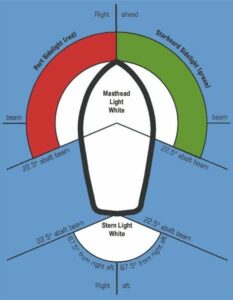Keep it Simple
Lights must be displayed on ALL vessels between Sunset and Sunrise and in restricted visibility.
Every type of craft on the water needs lights in order to be seen. Whether you’re in a powerboat, a sailboat or paddling, other water users need to recognise where you are and what you’re doing.
Mount lights to give you good night vision and to allow others to see you from every direction.
The Main Types
All round white light – A white light showing an unbroken light over an arc of 360 degrees. Must be minimum 1.0 metre above the gunwales and must be clear of obstruction like the cabin. May be used as an Anchor Light.
Sidelights – A green light on the starboard (right) side, and a red light on the port (left) side of a vessel. Each shows an unbroken light and is fixed to show from ahead to just behind the beam of the vessel on each side. On a vessel of less than 20 metres in length, the sidelights may be combined in one light unit, carried along the centreline of the vessel
Sternlight – A white light placed near the stern, showing an unbroken light over an arc of 135 degrees, fixed to show from behind the vessel.
Masthead light – A white light placed along the centreline of a vessel, showing an unbroken light over an arc of 225 degrees and fixed to show from anywhere ahead, to just behind the beams of the vessel. Has a similar arc to the sidelights combined.
Be Seen
Display the correct lights and have a working waterproof floating torch closeby. It may help others see you if you shine your torch on your sails or hull.
Keep a lookout
Navigating at night requires special attention; it can be like looking into a black hole. Look and listen at all times because some lights may not be as bright as others and background lights may hide them.
Spotlights can be used to identify specific hazards, but this should only be done when operating at very slow speed and without affecting other waterway users. It is unsafe to navigate a vessel with light illuminating the water directly ahead because it deprives you and other vessel operators of night vision.
Remember:
- Background lighting on the shore can cause confusion
- All vessels are required to show some form of lighting
- A safe speed is a speed at which sufficient action can be taken in time
- Some vessels moored in approved mooring areas and oyster leases may not be lit.
Power-driven vessels less than 12 metres in length that are underway must show the following lights:
- a masthead light, sidelights and a stern light, or
- an all-round white light (visible from 360 degrees), and sidelights.
A power-driven vessel of less than 7 metres in length, whose maximum speed does not exceed 7 knots, may exhibit an all-round white light only and, if practicable, also exhibit sidelights.
Anchored vessels less than 50 metres in length must show an all-round white light. Remember that anchoring in narrow channels and obstructing traffic is prohibited.
Drifting vessels must show the same navigation lights as if they were still making way. For example, if a power driven vessel is drifting it must show its white light.
Rowed or sailing vessels less than 7 metres long must as a minimum have a torch or lantern showing a white light ready to display in time to prevent collision.
Sailing vessels 7 metres or more must show sidelights and a sternlight when underway.
Sailing vessels propelled by engines are considered as power-driven vessels under the regulations and consequently MUST display the same lights.
More complicated lights on large vessels
If it is a large ship, the lights might be high and you may not realise that you are looking at the sides of a black hull. Consider every vessel a potential collision and keep well clear of large working vessels such as Ships, Tugs, Ferries, Barges etc.
Best wishes and safe boating.
John Sanders
Skipper
Boatschool





